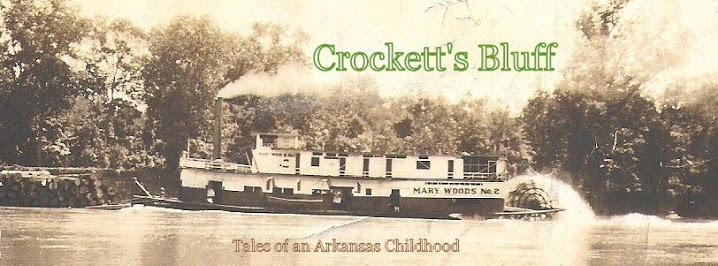I'm indebted, once again, to James Prange, the son of one of the elder sons of Adolph and Edna Prange -- and, from his testimony, the unofficial Prange family historian -- for the following images and information. In addition to a youthful image of his father, the elder James, he has "unearthed" an obviously priceless photograph of the rice chute and the Prange-Tindell warehouse above the Bluff itself, along with a delightful item of Crockett's Bluff news from the August 7, 1924 edition of the DeWitt Era Enterprise.
 |
| The River Boat "Lillian H" receiving bags of rice down the warehouse chute. |
The Woodiel house where I and my younger siblings Neil and Maureen were born was located north along the river from what one would have called the center of The Bluff. At the end of our lane stood the Lutheran Church and behind and beside it the Adolph Prange residence and the Prange Store that overlooked the White River. By the time I was old enough in the late nineteen thirties and early forties to venture alone as far afield from our house southward to where Rt. 153 made its turn toward DeWitt and St. Charles, scenes such as the one above were long gone. But the warehouse remained, and I remember it vividly.
After the war years the landmark Prange Bros. Enterprises water tower remained and was visible from five or more miles away across the prairie. The largely inactive August Prange company store remained during the post war decades along side Schwab's Store, that by the end of World War II had become the sole center of activity. The Adolph Prange family had closed their store in 1944 and moved to California.
By 1945, across the road but in the shadows of the water tower, "Doodle and Eddie"Schwab had developed a general store with a capital G -- the center of The Bluff. To the east a few hundred yards resting in the oak trees beyond the "Ida Carolyn Park" picnic area lay the largely vacant warehouse. To reach it one had to cross the bridge of the Prange Farm canal whose water was pumped from the river below the bluffs to drift southward along its banks to the vast rice fields that spread across the prairie beyond.
I remember the warehouse as large and open and quiet, save for the constantly fluttering sparrows, and although it was rarely filled with grain of any sort, unlike the Prange Farm's smaller barns a mile or so away, it maintained a distinctive aroma that must have been retained from years like the one pictured above when tons of rice and perhaps other grains, dried not yet from "dryers" but from having been left in shocks in the fields to dry in the sun, before being sacked and slid down the chute to be neatly stacked on a barge of the likes of The Lillian H.
Both the Adolph Prange store and the family residence were dismantled by the late 1950s; the water tower a decade or so later. After the war when the Lutheran Church had lain vacant for years, its primary seating area, minus the bell tower, was moved westward down Rt. 153 six miles or so where it remains today the meeting house of the Poplar Creek Baptist congregation..
This image of the chute from the warehouse might well be the only remaining visual record of this activity.
 |
| James Prange early 1920s |
 |
Early 1900s?
"I recognize several faces in this photo as Crockett's Bluff people. If my suspicion is correct that the young boy in the front kneeling down is my grandfather, then this photo was taken in the early 1900s." JP
|
 |
| Houseboat on the White River, perhaps John Johnson's |
DEWITT ERA ENTERPRISE, August 7, 1924
Judges for election in Crockett Township are Shelton Herring, Will Mason and Cecil Inman. Clerks named were Adolph Prange, U.A. Rowe, Harmon Turner.
Peaches are drying in the trees; corn is ruined; rice needs more water; pasturage is getting scarce, but still we wait for rain.
Prange Bros will soon be able to increase pumping capacity of their plant to about 4,000 gallons per minute. A third pump, driven by a large Fairbanks Engine, will be be put to work this week.
While visiting with her daughter, Mrs. Adolph Prange, Mrs. Burroughs came very near being seriously injured. A stray yearling attacked Mrs. Burroughs, and before anyone could come to her rescue, it succeeded in knocking Mrs. Burroughs to the ground and butting her severely.
October 2, 1924:
The thief who recently carried away two loads of bird shot from the Prange Mercantile Company, will be presented with buck shot at his next appearance.
Crockett's Bluff School opened on September 15, with an enrollment of 30.

.jpg)






